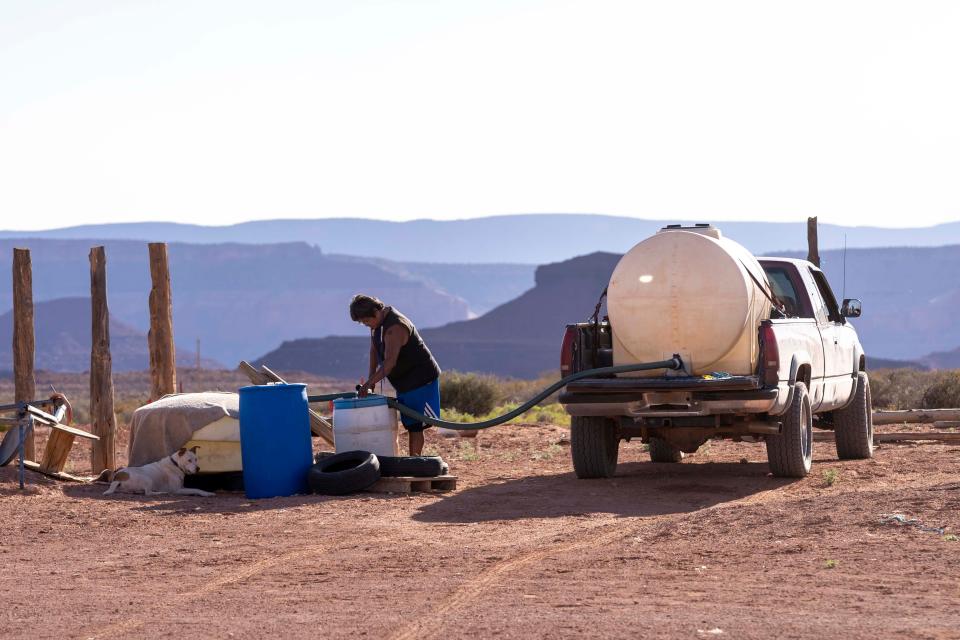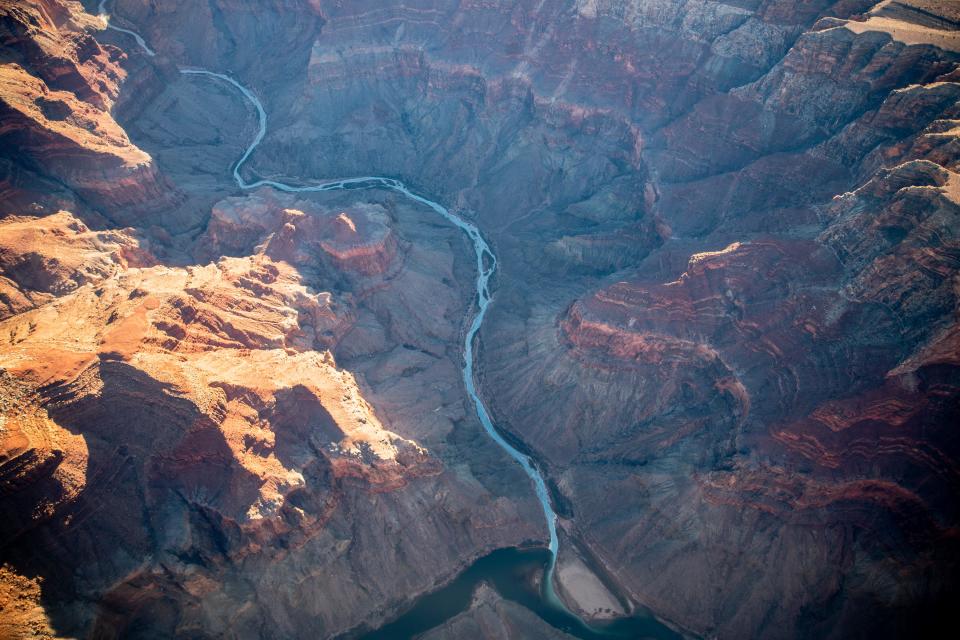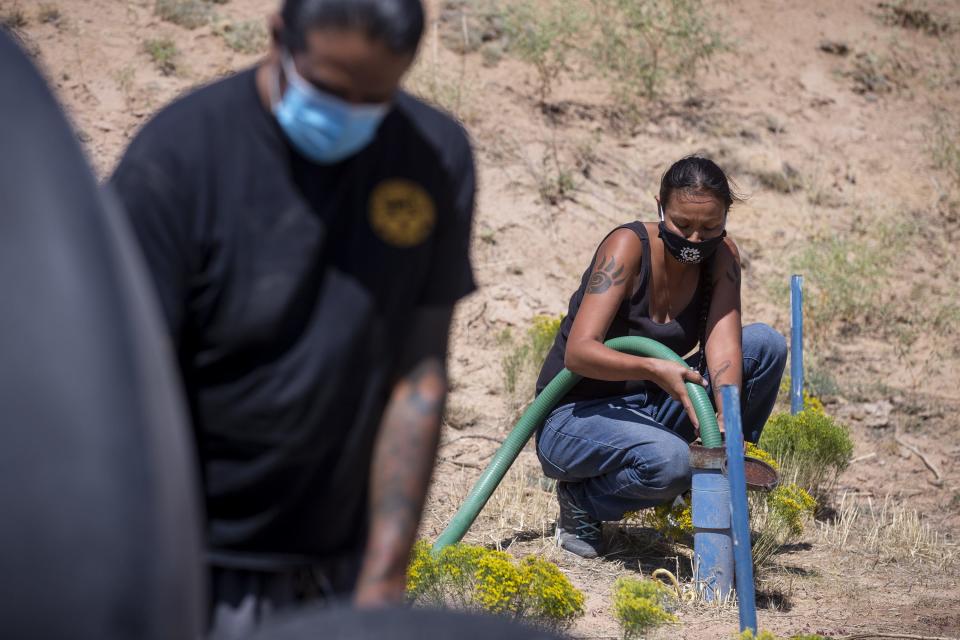Navajo leaders ratify historic Colorado River water settlement, await action by Congress
Navajo Nation President Buu Nygren signed a historic water settlement with the federal government on Friday, the day after the Navajo Nation Council approved it unanimously. Speaker Crystalyne Curley said she believes Congress will support the measure, finally bringing the promise of water for thousands of people.
The Northeastern Arizona Indian Water Rights Settlement Agreement, once passed by Congress, will settle the Navajo Nation’s claims to water rights to all Colorado River water in Arizona.
The separate Rio San José Stream System Water Rights Settlement Agreement will settle water rights claims in the Rio San José Stream System and the Rio Puerco Basin in New Mexico for the Navajo Nation if considered by Congress.
“These have been initiatives that have been going for many decades,” said Curley. “We made history today. I know this took many months…this is an opportunity for us to think 100 years ahead for our children.”

The settlement would end long years of legal disputes among the tribes and the state and federal governments and offer certainty for all sides as the rights to water resources are finally resolved. Its approval came nearly a year after the U.S. Supreme Court ruled that the federal government was not obligated to secure and deliver water across the Navajo Nation.
Included in the agreement is proposed funding of about $5 billion to build essential water projects required by the Navajo Nation, money that would require appropriations by Congress.
After the 25th Navajo Nation Council took office, along with Nygren and Vice President Richelle Montoya, a consensus emerged to address water rights claims, initiating discussions that had dragged on for years. Leaders emphasized that the effort was a collaborative endeavor involving Navajo Nation leadership, the Navajo Department of Justice, the Navajo Attorney General's office, the Navajo Department of Water Resources and the Navajo Nation Water Rights Commission.

“One thing we had to do was go back to all 17 agreements in the settlement agreement and that was a challenge within itself,” said Curley. “There have been attempts through council rights in the past and unfortunately it didn't come to this point of time when there was unanimous support.”
The Northeastern Arizona Indian Water Rights Settlement Agreement involves 17 participants, including the U.S. government, Arizona, and the Hopi and San Juan Southern Paiute Tribes. The settlement calls for the Navajo Nation to receive a substantial amount of Arizona's Colorado River Upper Basin water, some Lower Basin water, all the groundwater underlying the Navajo Nation, all surface water that reaches the Navajo Nation from the Little Colorado River, and all wash water that reaches the Nation south of the Hopi Reservation.
Planting seeds: How one Navajo farmer hopes to bring food and water security to others
“I think it was the change in time and change in generation, where we are not only dealing with droughts but post-COVID and climate change,” said Curley. “A challenge was getting aligned with all the parties and negotiating back and forth, but we all had that common goal that we had to protect what is ours, and secure for our children and grandchildren.”
Curley said they were informed that the Hopi and San Juan Southern Paiute Tribes both supported their resolutions to this agreement unanimously as well, which she described as another historic feat as all three tribes worked together to make “that same voice that we are going to fight Congress, fighting on the hill, for all of our water claims.”
"For the Hopi Tribe, this settlement is not just a legal document; it is a path forward," said Timothy L. Nuvangyaoma, chairman of the Hopi Tribe, and Craig Andrews the vice chair. "Under the agreement, the Hopi Tribe will have access to reliable water and water infrastructure necessary to ensure the health, well-being, and economic prosperity of the Hopi People for generations to come."
Among other things, they noted the agreement makes diverse water sources available to the Hopi Tribe to meet future water needs on the reservation, including reliable mainstream Colorado River water.
"It also provides inter-tribal agreements between the Hopi Tribe and the Navajo Nation to manage and protect groundwater resources shared by the tribes, highlighting principles of sustainability," Nuvangyaoma and Andrews said in their statement. "Most importantly, this settlement provides a way for Hopi to fulfill its covenant with Maasaw: to live as stewards of Hopitutskwa."

Agreements apportion water from various sources
According to the agreement, the Navajo Nation would receive 44,700 acre-feet per year from Arizona's allocation of the Upper Basin Colorado River water. The Navajo Nation's current litigation on water rights in Arizona only addresses claims in the Little Colorado River Basin. The Hopi tribe’s claim on that river would be less than one-third of what they once sought.
The settlement offers six things that continued litigation would not: Access to meaningful and reliable Upper Basin Colorado River Water; access to fourth-priority Lower Basin Colorado River Water; the ability to access Arizona water in New Mexico and Utah and move it to Arizona for use; the ability to use Upper Basin Colorado River Water in the Lower Basin communities, and vice versa; an alternative source of groundwater; and almost $5 billion in water delivery infrastructure.
The settlement includes all the Little Colorado River mainstream water that reaches the Navajo reservation, with historic flows that are estimated to be 122,000 acre-feet per year. For Hopi, that includes existing uses, the same limited new uses as permitted for non-Indian parties and certain limited rights to participate with the Navajo Nation in new and enlarged reservoir projects on or adjacent to Hopi land.
'Water is life': Native leaders honor sacred river spaces as courts debate water rights
Also included is 3,600-acre feet per year of fourth-priority Lower Basin Colorado River Water, along with 4,178 acre-feet per year of fourth-priority river water from the Cibola allocation, 750 acre-feet per year of fifth-priority Cibola water and 1,000 acre-feet per year of sixth-priority Cibola water.
“I’m still amazed that we made it to this point,” said Navajo Attorney General Ethel Branch. “It’s still the beginning. There is much that lies ahead in the process, like getting this to Congress, conforming the documents, filing the decree, and getting it accepted by the court. This is a strong important first step.”
The Rio San José Stream System Water Rights Settlement Agreement is expected to fund infrastructure for water delivery to a number of rural Navajo communities in New Mexico.
That settlement is proposed to cost $243 million. Funding will go toward wastewater development, chlorination stations, water-hauling stations, an operation and maintenance trust fund, a regional water system to import water and a water acquisition fund.
“These water right settlements provide an opportunity for us to diversify our water portfolio,” said Crystal Tulley-Cordova, a principal hydrologist in the Navajo Nation Department of Water Resources, “and to be able to help continue to live here on our permanent homeland. We will be closing the clean water access gap with the funding that is in these water right settlements.”

'Our trust relationship with the federal government means little'
Both settlements include a limited waiver of sovereign immunity, and grassroots groups such as the Diné Water Rights Coalition don’t agree with that. In fact, they don't agree with a lot of what's in the settlements, particularly the main Arizona agreement.
“What we learned in the 20th century was our trust relationship with the federal government means little,” the coalition said in a statement. “In the 21st century, nothing has changed. Western states continue to battle Navajo water claims and the federal government argued that the U.S. has no enforceable responsibility to protect Navajo’s claims this past summer. The loss of acquiring our full share has meant Navajo will be precluded from future development of the reservation and otherwise prevent the beneficial development of the reservation intended by Congress.”
The coalition suggested the Navajo Nation should advocate for its water rights in Arizona to ensure a permanent homeland for the Navajo people and their way of life, taking these steps:
Rather than claiming 44,700 AFY of Arizona’s Upper Basin allocation, the tribe should be claiming 50,000 AFY. In addition, all water permits issued to other users during the time the Navajo Generating Station agreements were in effect should be given to Navajo in this settlement.
Navajo should assert first-priority rights on the Lower Colorado River mainstream water, and seek actual quantified rights on the LCR mainstream. The tribe should also cap all further wells along the alluvial of the LCR on upstream users and require or ensure the water that reaches Navajo meets federal EPA water quality standards, as there are sources of contamination upstream.
No provisions should be made for industrial use when it comes to the Navajo Aquifer. Navajo needs to advocate to put the confined portion of the N-aquifer under EPA Aquifer Protection Program.
Andrew Curley, a University of Arizona professor, has been studying and closely monitoring Navajo water rights claims for nearly 20 years, and described the settlement as a culmination of many efforts. He has attended numerous meetings, including a recent public meeting at his chapter in Houck, noting that the process can be lengthy, repetitive and challenging for some to follow.
"People know what water is, they don't know how the states have refined water into a very hard-to-understand way of thinking about it," said Andrew Curley. "And that is to the advantage of colonization. If you talk about it in a way that is hard to understand, then it's easier for people to accept things that might not be good for us either in the short or long term."

What people need to remember is, "when they hear terms such as 'lower basin,' 'upper basin,' 'wet water' or 'paper water' these are all colonial terminology to refer to the Colorado River and its tributaries."
"These are ways settler societies have divided water amongst themselves and now are including us in their schemes," said Andrew Curley. "Do we have a better option of our inclusion? Currently, no and that's why settlement is seen as a good action on the part of the people who have negotiated it."
He noted that Arizona has historically used water settlements to resolve various other issues. He believes that most of these issues are no longer relevant. If the current water settlement passes at the congressional level, he said, it would mean the Navajo Nation agreeing to establish a Southern Paiute reservation within its territory, which he recently became aware of when he attended the meeting at Houck chapter.
Michelle Espino, assistant attorney general in the water rights unit, said that in 2000, the Navajo Nation Council approved a treaty between the Navajo Nation and Southern Paiute Tribe, designating a southern and northern reservation for the Southern Paiute Tribe. She said the northern designation would be placed in Utah and the southern would be located near Tuba City.
"Since that treaty, the tribes have been working to ratify the treaty," said Espino. "The reason for that ratification is because Congress needs to authorize the designation of that land for the Southern Paiute Tribe and to provide the directive to portion the land for the tribe. There has been effort in the past, and this congressional session there was legislation to do that ratification and as a result the U.S. team suggested that it be folded into this water rights settlement and also for the opportunity finalize the San Juan Southern Paiute water rights in addition with that land designation."
Curley, the UA professor, wondered whether the Navajo Nation is agreeing to a settlement at a time when Congress is willing to fund infrastructure for the Navajo Nation.
"Right now, Arizona is willing to play ball, prior to this the state of Arizona's congressional representation and state government has been oppositional to tribes not they are more hospitable to tribes," said Andrew Curley. "But, now the landscape of Congress has changed."
Arlyssa D. Becenti covers Indigenous affairs for The Arizona Republic and azcentral.com. Send ideas and tips to arlyssa.becenti@arizonarepublic.com.
Support local journalism. Subscribe to azcentral.com today.
This article originally appeared on Arizona Republic: Navajo leaders ratify historic Colorado River water settlement

